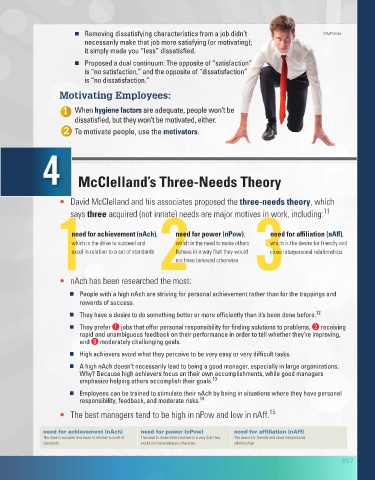Page 358 - Fundamentals of Management Myths Debunked (2017)_Flat
P. 358
◾ Removing dissatisfying characteristics from a job didn’t Olly/Fotolia
necessarily make that job more satisfying (or motivating);
it simply made you “less” dissatisfied.
◾ Proposed a dual continuum: The opposite of “satisfaction”
is “no satisfaction,” and the opposite of “dissatisfaction”
is “no dissatisfaction.”
Motivating Employees:
1 When hygiene factors are adequate, people won’t be
dissatisfied, but they won’t be motivated, either.
2 To motivate people, use the motivators.
4 Mcclelland’s Three-Needs Theory
• David McClelland and his associates proposed the three-needs theory, which
1 2 3
11
says three acquired (not innate) needs are major motives in work, including:
need for achievement (nAch),
need for affiliation (nAff),
need for power (nPow),
which is the need to make others
which is the desire for friendly and
which is the drive to succeed and
behave in a way that they would
excel in relation to a set of standards
close interpersonal relationships
not have behaved otherwise
• nAch has been researched the most:
◾ People with a high nAch are striving for personal achievement rather than for the trappings and
rewards of success.
◾ They have a desire to do something better or more efficiently than it’s been done before. 12
◾ They prefer ❶ jobs that offer personal responsibility for finding solutions to problems, ❷ receiving
rapid and unambiguous feedback on their performance in order to tell whether they’re improving,
and ❸ moderately challenging goals.
◾ High achievers avoid what they perceive to be very easy or very difficult tasks.
◾ A high nAch doesn’t necessarily lead to being a good manager, especially in large organizations.
Why? Because high achievers focus on their own accomplishments, while good managers
emphasize helping others accomplish their goals. 13
◾ Employees can be trained to stimulate their nAch by being in situations where they have personal
responsibility, feedback, and moderate risks. 14
• The best managers tend to be high in nPow and low in nAff. 15
need for achievement (nAch) need for power (nPow) need for affiliation (nAff)
The drive to succeed and excel in relation to a set of The need to make others behave in a way that they The desire for friendly and close interpersonal
standards would not have behaved otherwise relationships
357

